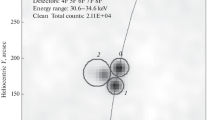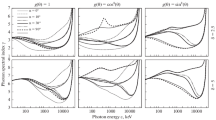Abstract
The Reuven Ramaty High Energy Solar Spectroscopic Imager (RHESSI) provides hard X-ray spectral observations with \({\approx}\,1~\mbox{keV}\) resolution to study flare-accelerated (\({>}\,10~\mbox{keV}\)) electrons through their bremsstrahlung emission. Here we report on a statistical study of RHESSI flares with emission above 150 keV, focusing on the spectral shape at the hard X-ray peak. Spectral parameters are derived by fitting the photon spectrum with a broken power law and by the standard thick-target fit. Consistent with previous studies, the most common spectral shape of the photon spectrum (52 out of 65 events) is a double power law with a downward break (“knee”), with ten events showing a single power law and three events having an upward break (“ankle”). The spectral breaks occur typically around 55 keV and the difference of the spectral index above and below the break, \(\gamma _{2}\) and \(\gamma _{1}\), is typically between 0.3 and 1. We show correlations between the downward break parameters. The most prominent correlation, with a rank order coefficient of \(\rho =0.92\), is between the power-law indices above and below the break: \(\gamma _{1} = (0.74\pm 0.04)\gamma _{2} + (0.34 \pm 0.14)\). Applying a thick target fit to the photon spectrum, a similar correlation is also found for the flare-accelerated electron spectra with \(\delta _{1} =(0.85\pm 0.08)\delta _{2} - (0.3\pm 0.3)\) (\(\rho =0.67\)). Spectral breaks could be a property of the acceleration mechanism itself or they could be a secondary effect produced by particle transport or wave-particle interactions. Any theoretical models should be consistent with these correlations. In addition, we find that one upward and 23 (49%) downward breaks are consistent with nonuniform ionization within the thick target.




Similar content being viewed by others
Notes
Object Spectral Executive, cf. http://hesperia.gsfc.nasa.gov/ssw/packages/spex/doc/ospex_explanation.htm .
References
Alaoui, M., Holman, G.D.: 2017, Astrophys. J. 851, 78. DOI .
Alexander, R.C., Brown, J.C.: 2002, Solar Phys. 210, 407. DOI .
Bai, T., Ramaty, R.: 1978, Astrophys. J. 219, 705. DOI .
Battaglia, M., Grigis, P.C., Benz, A.O.: 2005, Astron. Astrophys. 439, 737. DOI .
Brown, J.C.: 1971, Solar Phys. 18, 489. DOI .
Casadei, D., Jeffrey, N.L.S., Kontar, E.P.: 2017, Astron. Astrophys. 606, A2. DOI .
Christe, S., Hannah, I.G., Krucker, S., McTiernan, J., Lin, R.P.: 2008, Astrophys. J. 677, 1385. DOI .
Conway, A.J., Brown, J.C., Eves, B.A.C., Kontar, E.: 2003, Astron. Astrophys. 407, 725. DOI .
Dickson, E.C.M., Kontar, E.P.: 2013, Solar Phys. 284, 405. DOI .
Dulk, G.A., Kiplinger, A.L., Winglee, R.M.: 1992, Astrophys. J. 389, 756. DOI .
Grigis, P.C., Benz, A.O.: 2004, Astron. Astrophys. 426, 1093. DOI .
Hannah, I.G., Christe, S., Krucker, S., Hurford, G.J., Hudson, H.S., Lin, R.P.: 2008, Astrophys. J. 677, 704. DOI .
Holman, G.D.: 2012, Astrophys. J. 745, 52. DOI .
Holman, G.D., Mariska, J.T., McTiernan, J.M., Ofman, L., Petrosian, V., Ramaty, R.: 2001, Bull. Am. Astron. Soc. 33, 1444.
Holman, G.D., Sui, L., Schwartz, R.A., Emslie, A.G.: 2003, Astrophys. J. Lett. 595, L97. DOI .
Kašparová, J., Kontar, E.P., Brown, J.C.: 2007, Astron. Astrophys. 466, 705. DOI .
Knight, J.W., Sturrock, P.A.: 1977, Astrophys. J. 218, 306. DOI .
Kontar, E.P., Brown, J.C., McArthur, G.K.: 2002, Solar Phys. 210, 419. DOI .
Kontar, E.P., Reid, H.A.S.: 2009, Astrophys. J. Lett. 695, L140. DOI .
Kontar, E.P., MacKinnon, A.L., Schwartz, R.A., Brown, J.C.: 2006, Astron. Astrophys. 446, 1157. DOI .
Kontar, E.P., Emslie, A.G., Massone, A.M., Piana, M., Brown, J.C., Prato, M.: 2007, Astrophys. J. 670, 857. DOI .
Krucker, S., Lin, R.P.: 2008, Astrophys. J. 673, 1181. DOI .
Krucker, S., Oakley, P.H., Lin, R.P.: 2009, Astrophys. J. 691, 806. DOI .
Krucker, S., Kontar, E.P., Christe, S., Lin, R.P.: 2007, Astrophys. J. Lett. 663, L109. DOI .
Landini, M., Monsignori Fossi, B.C., Pallavicini, R.: 1973, Solar Phys. 29, 93. DOI .
Lin, R.P., Hudson, H.S.: 1971, Solar Phys. 17, 412. DOI .
Lin, R.P., Schwartz, R.A.: 1987, Astrophys. J. 312, 462. DOI .
Lin, R.P., Dennis, B.R., Hurford, G.J., Smith, D.M., Zehnder, A., Harvey, P.R., Curtis, D.W., Pankow, D., Turin, P., Bester, M., Csillaghy, A., Lewis, M., Madden, N., van Beek, H.F., Appleby, M., Raudorf, T., McTiernan, J., Ramaty, R., Schmahl, E., Schwartz, R., Krucker, S., Abiad, R., Quinn, T., Berg, P., Hashii, M., Sterling, R., Jackson, R., Pratt, R., Campbell, R.D., Malone, D., Landis, D., Barrington-Leigh, C.P., Slassi-Sennou, S., Cork, C., Clark, D., Amato, D., Orwig, L., Boyle, R., Banks, I.S., Shirey, K., Tolbert, A.K., Zarro, D., Snow, F., Thomsen, K., Henneck, R., McHedlishvili, A., Ming, P., Fivian, M., Jordan, J., Wanner, R., Crubb, J., Preble, J., Matranga, M., Benz, A., Hudson, H., Canfield, R.C., Holman, G.D., Crannell, C., Kosugi, T., Emslie, A.G., Vilmer, N., Brown, J.C., Johns-Krull, C., Aschwanden, M., Metcalf, T., Conway, A.: 2002, Solar Phys. 210, 3. DOI .
Massone, A.M., Emslie, A.G., Kontar, E.P., Piana, M., Prato, M., Brown, J.C.: 2004, Astrophys. J. 613, 1233. DOI .
Smith, D.M., Lin, R.P., Turin, P., Curtis, D.W., Primbsch, J.H., Campbell, R.D., Abiad, R., Schroeder, P., Cork, C.P., Hull, E.L., Landis, D.A., Madden, N.W., Malone, D., Pehl, R.H., Raudorf, T., Sangsingkeow, P., Boyle, R., Banks, I.S., Shirey, K., Schwartz, R.: 2002, Solar Phys. 210, 33. DOI .
Su, Y., Holman, G.D., Dennis, B.R.: 2011, Astrophys. J. 731, 106. DOI .
Su, Y., Holman, G.D., Dennis, B.R., Tolbert, A.K., Schwartz, R.A.: 2009, Astrophys. J. 705, 1584. DOI .
Sui, L., Holman, G.D., Dennis, B.R.: 2007, Astrophys. J. 670, 862. DOI .
Warmuth, A., Holman, G.D., Dennis, B.R., Mann, G., Aurass, H., Milligan, R.O.: 2009, Astrophys. J. 699, 917. DOI .
Zharkova, V.V., Gordovskyy, M.: 2005, Astron. Astrophys. 432, 1033. DOI .
Zharkova, V.V., Gordovskyy, M.: 2006, Astrophys. J. 651, 553. DOI .
Acknowledgements
We would like to thank Robert Lin for major contributions to the spectral analysis and interpretation in this paper. We also acknowledge Brian Dennis, Gordon Holman, Richard Schwartz, and Kim Tolbert for critical comments. The work was supported through NASA contract NAS 5-98033 for RHESSI.
Author information
Authors and Affiliations
Corresponding author
Ethics declarations
Disclosure of Potential Conflicts of Interest
The authors declare that they have no conflicts of interest.
Additional information
Publisher’s Note
Springer Nature remains neutral with regard to jurisdictional claims in published maps and institutional affiliations.
Appendices
Appendix A: Single versus Multiple Detectors Analysis
To test how cross-detector calibration affects our results, we analyze the spectra from our sample with each detector separately. In Figure 5 we show the mean value of the difference of the fitting parameters between summed and individual detectors: \(\langle X-X_{[i]}\rangle\), where \(X\) is the fitting parameter (spectral index or break energy) from summing over seven detectors and \(X_{[i]}\) is the fitting parameter using detector \(i\). The green error bars represent the FWHM from a Gaussian fit to \(\langle X-X_{[i]}\rangle\) and the black error bars are calculated such as: \(\mbox{error}(\langle X- X _{[i]}\rangle)=\frac{\sigma }{{\sqrt{n}}}\) with \(n=65\) flares and \(\sigma =\frac{ \text{FWHM} }{{2 \sqrt{2 \ln2}}}\). Fits using detector 2 are not shown since its low resolution and threshold of \({\approx}\,25~\mbox{keV}\) makes it unsuitable for spectroscopy. Detector 7, although not used in our statistical study, gives fairly good results in finding the nonthermal fit parameters (the spectral indices and \(\epsilon_{\mathrm{br}}\)). However, the residuals at energies lower than \({\approx}\,20~\mbox{keV}\) are not acceptable. In conclusion, summing over all detectors but 2 and 7 or using individual detectors does not change the spectral fitting parameters significantly.
Comparing fit parameters derived from single detector spectra and spectra averaged over all detectors (excluding detectors 2 and 7). Each panel shows the difference in fitting parameters averaged over all events in our sample. From left to right, the difference in \(\gamma 1\), \(\gamma 2\), and the break energy are shown.
Appendix B: Table of Events
Rights and permissions
About this article
Cite this article
Alaoui, M., Krucker, S. & Saint-Hilaire, P. Statistical Study of Hard X-Ray Spectral Breaks in Solar Flares. Sol Phys 294, 105 (2019). https://doi.org/10.1007/s11207-019-1495-6
Received:
Accepted:
Published:
DOI: https://doi.org/10.1007/s11207-019-1495-6





